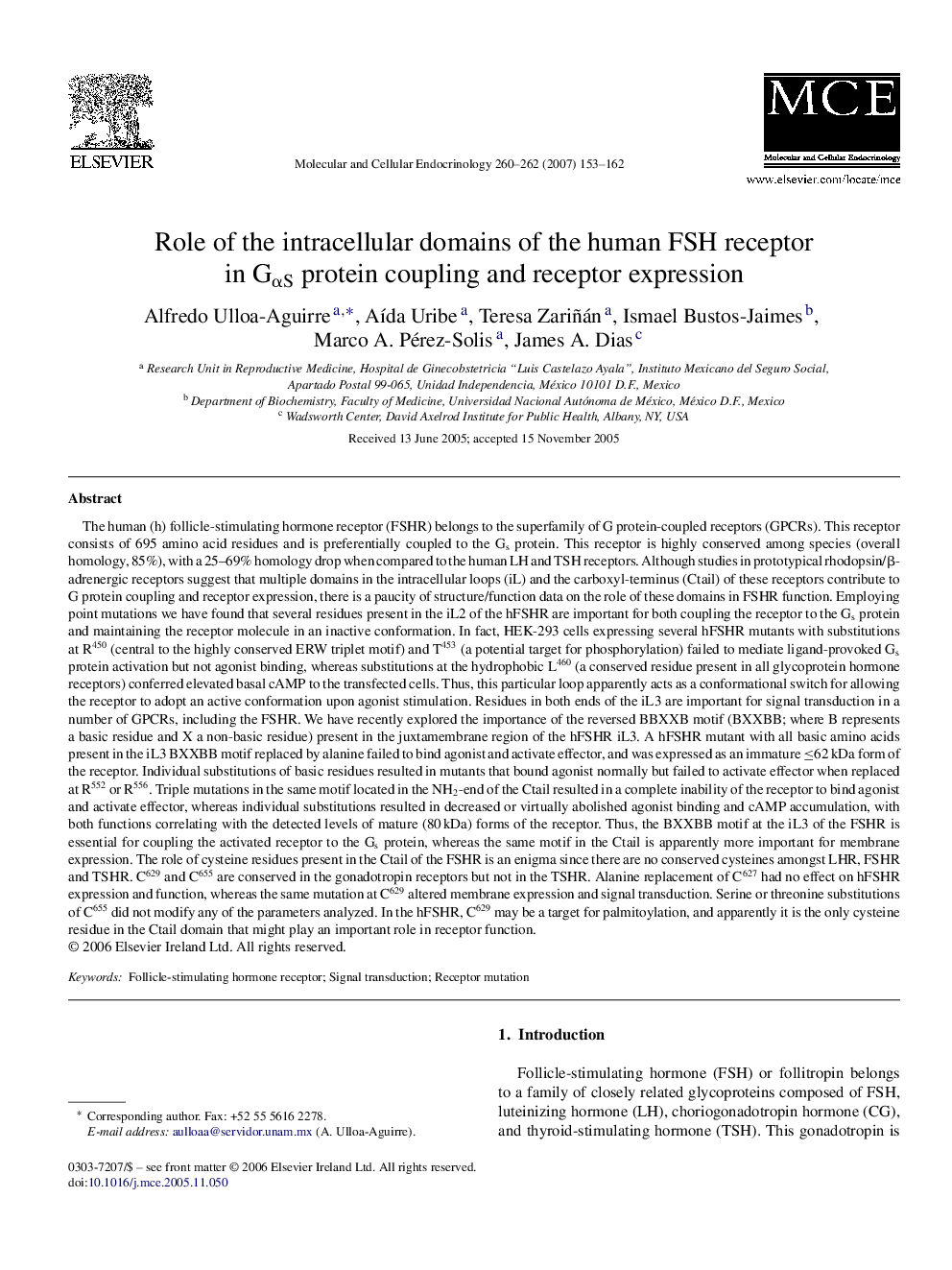| کد مقاله | کد نشریه | سال انتشار | مقاله انگلیسی | نسخه تمام متن |
|---|---|---|---|---|
| 8478268 | 1550999 | 2007 | 10 صفحه PDF | دانلود رایگان |
عنوان انگلیسی مقاله ISI
Role of the intracellular domains of the human FSH receptor in GαS protein coupling and receptor expression
دانلود مقاله + سفارش ترجمه
دانلود مقاله ISI انگلیسی
رایگان برای ایرانیان
کلمات کلیدی
موضوعات مرتبط
علوم زیستی و بیوفناوری
بیوشیمی، ژنتیک و زیست شناسی مولکولی
بیولوژی سلول
پیش نمایش صفحه اول مقاله

چکیده انگلیسی
The human (h) follicle-stimulating hormone receptor (FSHR) belongs to the superfamily of G protein-coupled receptors (GPCRs). This receptor consists of 695 amino acid residues and is preferentially coupled to the Gs protein. This receptor is highly conserved among species (overall homology, 85%), with a 25-69% homology drop when compared to the human LH and TSH receptors. Although studies in prototypical rhodopsin/β-adrenergic receptors suggest that multiple domains in the intracellular loops (iL) and the carboxyl-terminus (Ctail) of these receptors contribute to G protein coupling and receptor expression, there is a paucity of structure/function data on the role of these domains in FSHR function. Employing point mutations we have found that several residues present in the iL2 of the hFSHR are important for both coupling the receptor to the Gs protein and maintaining the receptor molecule in an inactive conformation. In fact, HEK-293 cells expressing several hFSHR mutants with substitutions at R450 (central to the highly conserved ERW triplet motif) and T453 (a potential target for phosphorylation) failed to mediate ligand-provoked Gs protein activation but not agonist binding, whereas substitutions at the hydrophobic L460 (a conserved residue present in all glycoprotein hormone receptors) conferred elevated basal cAMP to the transfected cells. Thus, this particular loop apparently acts as a conformational switch for allowing the receptor to adopt an active conformation upon agonist stimulation. Residues in both ends of the iL3 are important for signal transduction in a number of GPCRs, including the FSHR. We have recently explored the importance of the reversed BBXXB motif (BXXBB; where B represents a basic residue and X a non-basic residue) present in the juxtamembrane region of the hFSHR iL3. A hFSHR mutant with all basic amino acids present in the iL3 BXXBB motif replaced by alanine failed to bind agonist and activate effector, and was expressed as an immature â¤62 kDa form of the receptor. Individual substitutions of basic residues resulted in mutants that bound agonist normally but failed to activate effector when replaced at R552 or R556. Triple mutations in the same motif located in the NH2-end of the Ctail resulted in a complete inability of the receptor to bind agonist and activate effector, whereas individual substitutions resulted in decreased or virtually abolished agonist binding and cAMP accumulation, with both functions correlating with the detected levels of mature (80 kDa) forms of the receptor. Thus, the BXXBB motif at the iL3 of the FSHR is essential for coupling the activated receptor to the Gs protein, whereas the same motif in the Ctail is apparently more important for membrane expression. The role of cysteine residues present in the Ctail of the FSHR is an enigma since there are no conserved cysteines amongst LHR, FSHR and TSHR. C629 and C655 are conserved in the gonadotropin receptors but not in the TSHR. Alanine replacement of C627 had no effect on hFSHR expression and function, whereas the same mutation at C629 altered membrane expression and signal transduction. Serine or threonine substitutions of C655 did not modify any of the parameters analyzed. In the hFSHR, C629 may be a target for palmitoylation, and apparently it is the only cysteine residue in the Ctail domain that might play an important role in receptor function.
ناشر
Database: Elsevier - ScienceDirect (ساینس دایرکت)
Journal: Molecular and Cellular Endocrinology - Volumes 260â262, 2 January 2007, Pages 153-162
Journal: Molecular and Cellular Endocrinology - Volumes 260â262, 2 January 2007, Pages 153-162
نویسندگان
Alfredo Ulloa-Aguirre, AÃda Uribe, Teresa Zariñán, Ismael Bustos-Jaimes, Marco A. Pérez-Solis, James A. Dias,